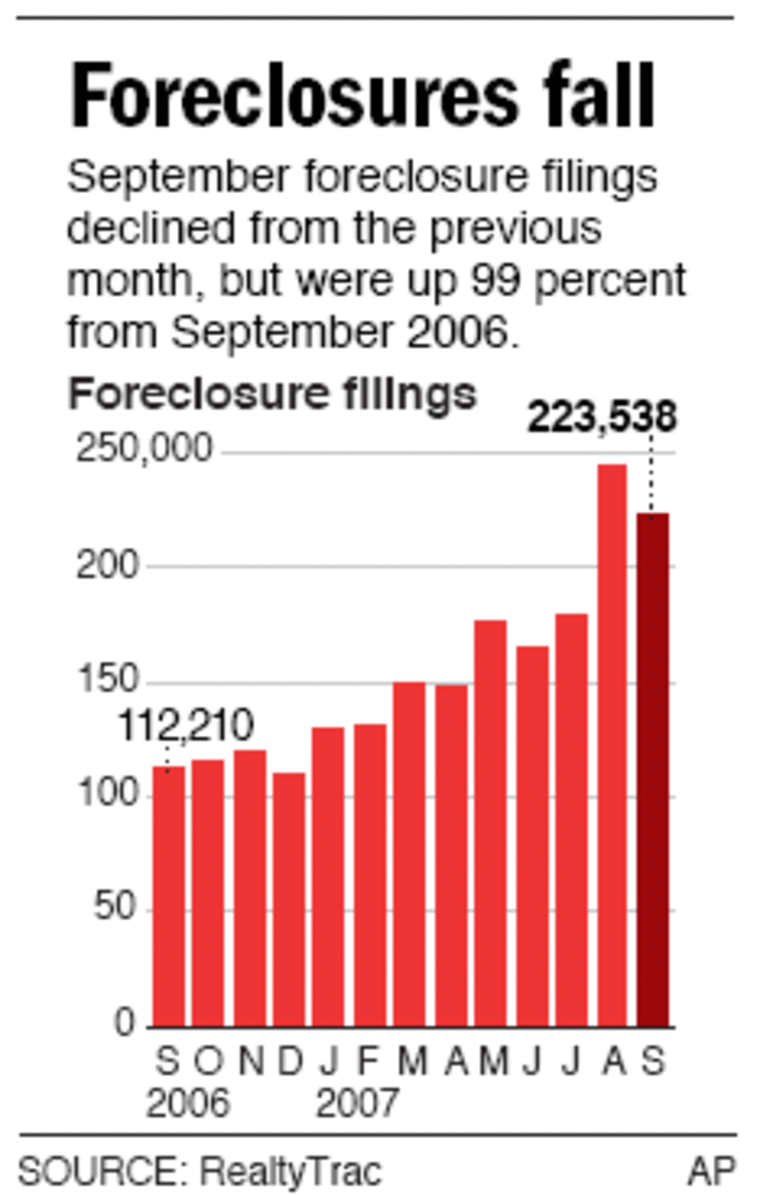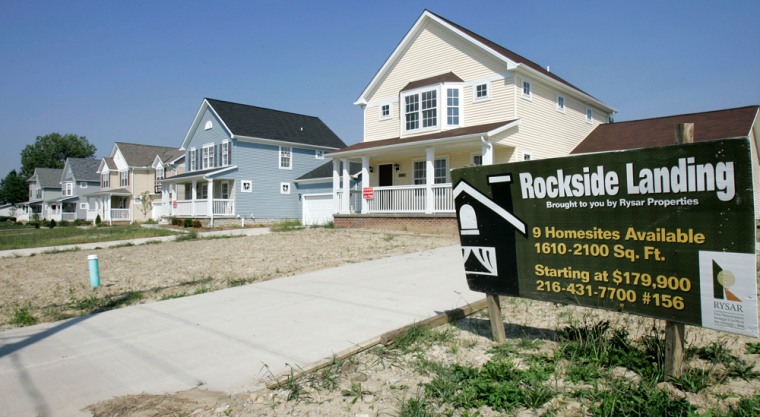Despite a dip in foreclosures last month, it appears unlikely that the wave of bad loans that have forced record numbers from their homes will peak any time soon. And despite efforts by lenders, politicians and homeowners to stem the tide, borrowers trying to work out better loan terms and save their homes face a thicket of red tape.
Data released Thursday by RealtyTrac, which publishes a database that tracks foreclosures, show that 223,538 foreclosures and related filings were reported in September. That represents about one in every 557 households.
That was down 8 percent from August — when the rate hit a 32-month high —but roughly double the number of foreclosures reported in September 2006. So it’s still far too soon to assume that the September dip indicates that foreclosures are peaking.
For one thing, another wave of interest rate "resets" is expected to hit over the next year, squeezing millions more borrowers’ budgets and putting their loans — and their homes — at risk.
“I wouldn’t bet the farm on this being the peak,” said Rick Sharga, vice president of marketing for RealtyTrac.
Like everything else in real estate, the level of foreclosure activity varies greatly depending on your location, and the highest rates of foreclosure continue to be concentrated in a relatively few states. Nevada had the highest foreclosure rate for the ninth month in a row — one filing for every 185 households. That was down 11 percent from August, but nearly triple the rate from a year earlier.
Other states posting high foreclosure rates were Florida, with one filing for every 248 households, and California, where more than 51,000 filings were reported in September, the most in any state. Other states with foreclosure rates ranking among the nation’s 10 highest were Michigan, Arizona, Georgia, Ohio, Colorado, Texas and Indiana.

The pace of foreclosures has been fueled by a wave of adjustable rate mortgage resets that can bring a sharp jump in monthly payments after the initial low “teaser” rate expires after two or three years, depending on the loan. The volume of those resets is expected to decline over the next few months, according to data assembled by Credit Suisse.
But a newer vintage of loans that are scheduled to start resetting later next year threatens to bring another round of monthly payment increases that could overwhelm more household budgets, creating a new wave of foreclosures, which could further delay the housing recovery.
On Wednesday, a real estate trade group said home sales will fall more sharply this year than previously forecast. In its eighth downwardly revised forecast, the National Association of Realtors said sales of existing homes this year will be down nearly 11 percent from last year. Sales of new homes are expected to post their worst year in a decade.
Prices for existing homes are expected to fall 1.3 percent by year-end to a median of $210,200 as the housing market weathers its steepest downturn in 16 years.
Those national statistics mask a range of local conditions. In some markets, the pace of sales and prices has held up relatively well. Areas that saw the biggest price run-ups during the housing boom are getting hit the hardest.
A California Realtors group predicted Wednesday that home sales and prices will fall further next year as the inventory of unsold and foreclosed homes rises while buyers hold out for better prices. Statewide, sales are expected to fall 9 percent to 334,500 units; the median price is seen falling 4 percent to $553,000.
Private forecasters say the drop in prices could be even steeper. Stephen Levy, senior economist at the Center for Continuing Study of the California Economy, expects prices to drop 10 to 15 percent overall, with sharper declines possible in some markets.
The association forecast "conveys the wrong image to people about what's going to happen in prices in their neighborhood from now on," Levy said. "It's going to be more severe. I think that's good. I think it's better for us if we get through the correction faster."
Meanwhile, as the number of unsold homes piles up in some markets, some potential buyers are having a harder time getting loans, and lending standards have tightened for those who can. That’s reduced the number of potential buyers for unsold homes.
With Democrats on the campaign trail proposing various measures to help homeowners facing foreclosure, the White House has also been trying to get out in front of the issue.
“My guess is that this foreclosure issue is going to be a major political football during the election,” said Sharga. “That could either lead to both parties not doing anything so they can blame the other or both fighting each other to come up with novel solutions to help homeowners who are losing properties.”
The latest proposal came Wednesday from the White House, when Treasury Secretary Henry Paulson said an industry coalition was working to help homeowners head off foreclosures and keep their homes. Paulson said 11 of the largest mortgage service companies, which together handle 60 percent of the nation's mortgages, had agreed to join the new coalition. Other members will include mortgage counseling agencies, investors and large trade organizations.
Democrats have said the White House actions so far have been too little and too late to significantly address the problem.
The solution to the problem will likely take more than new spending or tax dollars. Most lenders would prefer not to foreclose because the process almost always costs them money; foreclosed homes are usually priced for quick sale, which means they may not cover the unpaid loan outstanding.
But homeowners often fail to approach lenders until they are too far behind to work out a restructured payment plan. Many have trouble even identifying who their lender is. Most mortgages are sold off to investors and then serviced by separate companies. Some regulations designed to protect consumers from overly aggressive collection agents may bar lenders from contacting homeowners whose loans are in trouble.
Unscrambling the foreclosure mess has been further complicated by the huge volume of bundled loans that were chopped up by Wall Street and sold off to investors.
“There are just so many elements to this process that are screwed up or broken that it’s mind-boggling,” said Sharga. “It’s a maze of restrictions and regulations and complications that you almost need a third party to come in and slice through because that’s the only way you’re going to be able to make it work.”
